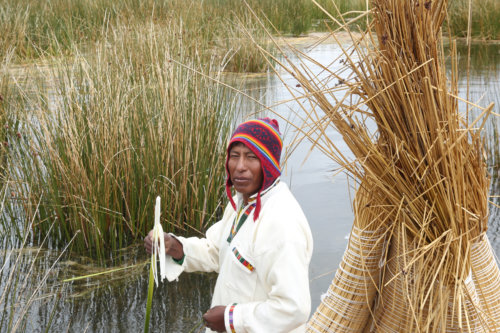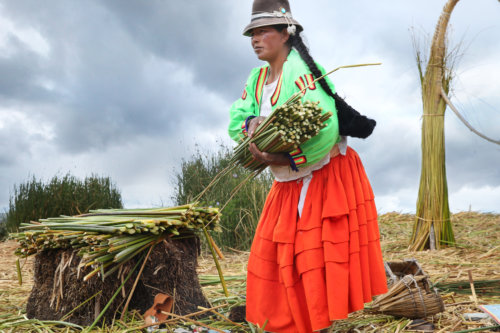
On Titikaka Lake in Peru, Reeds Are A Way of Life
On the border of Peru and Bolivia, surrounded by the Andes, Lake Titikaka (sometimes stylized Titicaca) is the largest lake in South America. Historically, Lake Titikaka was a site sacred to many Andean cultures; it was considered an origin point for humanity, the very source of the universe.
Among the many people who have called Lake Titikaka home over the centuries are the Uros, an indigenous tribe who have built the eponymous Uro archipelago: a series of 80 man-made islands that have existed for hundreds of years. Over the course of decades, the Uros have crafted every single island from a local plant known as the totora reed.
Though much confusion surrounds their origins, it is believed that the Uros first came to live on the islands after migrating from the Amazon and being pushed out of any viable farmland because their darker skin. The Incas and the Spanish both considered the Uros a lesser people and consequently never bothered them– a prejudice that still exists today.
At first, the Uros lived in boats made from totora reed, which grows abundantly around Titikaka Lake. But as they became more skilled at harvesting and building with totora, the Uros started to develop a system of floating platforms, which are still used as the foundation for several family homes today. When treated with new layers of totora reed, every island, which doubles as a home for multiple families, lasts around 30 years.
Besides using the reeds as a living foundation, the Uros have found ways to fashion the plant into industrial materials like timber for houses, furniture, and ships, as well as more day to day commodities like food, tea, and medicine. Called platano de agua (water banana), Uros sometimes peel the skin of totora reeds and eat the inner flesh of the spire, while the reeds’ brown blossoms can be used as a medicine for ailing stomachs and to stabilize digestion. The inner white part of the reed is also used to help ease alcohol-related hangovers.
But while the reed permeates most aspects of the daily life, harvesting totora is not easy. The Uros have to dive into cold water to cut the plant at its root in order to get spires that are as long as possible. Once their floating homes are complete, Uro craftsmen will affix each island to the lake bed to ensure the homes won’t float over the border into Bolivian waterways, which is territorially problematic as the Uro people don’t have valid visas.
Following industrialization at the beginning of the 19th century, Puno (a city along the Western shore of Titikaka Lake) boomed with industry, leading to devastating amounts of pollution in the Lake Titikaka area. Though parts of Lake Titikaka were converted to a Natural Reserve around the same period, the water pollution remains a great problem for the Uros, as they drink the water from the lake and continue to use it for cooking.
In response to the growing pollution epidemic, several international initiatives aimed at conserving and restoring the lake were established to improve water quality. Today, the floating islands of Titikaka Lake each have their own Elena (equivalent to a mayor or president). Once a year, the Uros elect a new representative, who can remain in their position indefinitely as long as the majority of locals are satisfied with their governance. Together, the community hopes to preserve the Uros and their islands, protecting a place where one of the last remaining Old World cultures continues to live peacefully atop the waves.







































